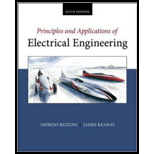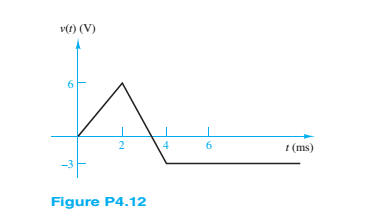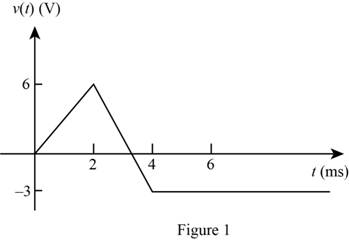
Concept explainers
The voltage across a 0.5-mH inductor, Plotted as a function of time, is shown in Figure P4.12. Determine the current through the inductor at

The current through the inductor at
Answer to Problem 4.12HP
The current through the inductor at
Explanation of Solution
Calculation:
The given diagram is shown in Figure 1

The conversion from
The conversion from
The conversion from
The conversion from
The conversion from
The conversion from
From the graph the expression for the voltage between the points
From the graph the expression for the voltage between the points
From the graph the expression for the voltage at
The expression for the voltage across the inductor is given by,
The initial current through the inductor is given by,
The expression for the current through the inductor is given by,
Substitute
From equation (1) the current through the inductor for the time interval
Substitute
Substitute
From equation (1) the current through the inductor for the time interval
Substitute
Solve further as,
Substitute
The expression for the current through the inductor for interval
Substitute
Substitute
Conclusion:
Therefore, the current through the inductor at
Want to see more full solutions like this?
Chapter 4 Solutions
Principles and Applications of Electrical Engineering
- The voltage across and the current through acapacitor are shown in Figure P4.21. Determine thevalue of the capacitance.arrow_forwardIf the waveform shown in Figure P4.15 is thevoltage across a capacitor plotted as a function of timewithvPK = 20V, T = 40 μs, C = 680nFdetermine and plot the waveform for the currentthrough the capacitor as a function of time.arrow_forwardConsider the circuit of Figure P4.17, in which the switch instantaneously moves back and forth between contacts A and B, spending 2 seconds in each position. Thus, the capacitor repeatedly charges for 2 seconds and then discharges for 2 seconds. Assume that v C ( 0 )=0 and that the switch moves to position A at t=0. Determine v C ( 2 ), v C ( 4 ), v C ( 6 ), and v C ( 8 ).arrow_forward
- Suppose we have a capacitance C discharging through a resistance R. Define and give an expression for the time constant. To attain a long time constant, do we need large or small values for R? For C?arrow_forwardThe voltage waveform shown in Figure P4.24appears across a 100-mH inductor and a 500-μFcapacitor. Plot the capacitor and inductor currents,iC(t) and iL(t), assuming iL(0) = 0A.arrow_forwardThe initial voltage across the capacitor shown in Figure P4.3 is v C ( 0+ )=0. Find an expression for the voltage across the capacitor as a function of time, and sketch to scale versus timearrow_forward
- The initial voltage across the capacitor shown in Figure P4.3 is v C ( 0+ )=−10 V. Find anexpression for the voltage across the capacitor as a function of time. Also, determine the time t0at which the voltage crosses zero.arrow_forwardConsider the circuit shown in Figure P4.40. A voltmeter (VM) is connected across the inductance. The switch has been closed for a long time. When the switch is opened, an arc appears across the switch contacts. Explain why. Assuming an ideal switch and inductor, what voltage appears across the inductor when the switch is opened? What could happen to the voltmeter when the switch opens?arrow_forwardThe current waveform shown in Figure P4.23 flowsthrough a 2-H inductor. Plot the inductor voltage vL(t).arrow_forward
- When we talk about capacitance of capacitor we normally say that capacitance depends on the size, shape, and position of the two capacitors and dielectric constant K. What then did we mean when we say that capacitance is constant in the equation Q = CV?arrow_forwardWhat is the equation thst represents the relationship between charge, capacitance and voltage for a capacitor.arrow_forwardWe know that the capacitor shown in Figure P4.11 is charged to a voltage of 10 V priorto t=0.a. Find expressions for the voltage across the capacitor vC(t) and the voltage across theresistor vR(t) for all time.b. Find an expression for the power delivered to the resistor.c. Integrate the power from t=0 to t=∞ to find the energy delivered.d. Show that the energy delivered to the resistor is equal to the energy stored in thecapacitor prior to t=0.arrow_forward
 Introductory Circuit Analysis (13th Edition)Electrical EngineeringISBN:9780133923605Author:Robert L. BoylestadPublisher:PEARSON
Introductory Circuit Analysis (13th Edition)Electrical EngineeringISBN:9780133923605Author:Robert L. BoylestadPublisher:PEARSON Delmar's Standard Textbook Of ElectricityElectrical EngineeringISBN:9781337900348Author:Stephen L. HermanPublisher:Cengage Learning
Delmar's Standard Textbook Of ElectricityElectrical EngineeringISBN:9781337900348Author:Stephen L. HermanPublisher:Cengage Learning Programmable Logic ControllersElectrical EngineeringISBN:9780073373843Author:Frank D. PetruzellaPublisher:McGraw-Hill Education
Programmable Logic ControllersElectrical EngineeringISBN:9780073373843Author:Frank D. PetruzellaPublisher:McGraw-Hill Education Fundamentals of Electric CircuitsElectrical EngineeringISBN:9780078028229Author:Charles K Alexander, Matthew SadikuPublisher:McGraw-Hill Education
Fundamentals of Electric CircuitsElectrical EngineeringISBN:9780078028229Author:Charles K Alexander, Matthew SadikuPublisher:McGraw-Hill Education Electric Circuits. (11th Edition)Electrical EngineeringISBN:9780134746968Author:James W. Nilsson, Susan RiedelPublisher:PEARSON
Electric Circuits. (11th Edition)Electrical EngineeringISBN:9780134746968Author:James W. Nilsson, Susan RiedelPublisher:PEARSON Engineering ElectromagneticsElectrical EngineeringISBN:9780078028151Author:Hayt, William H. (william Hart), Jr, BUCK, John A.Publisher:Mcgraw-hill Education,
Engineering ElectromagneticsElectrical EngineeringISBN:9780078028151Author:Hayt, William H. (william Hart), Jr, BUCK, John A.Publisher:Mcgraw-hill Education,





